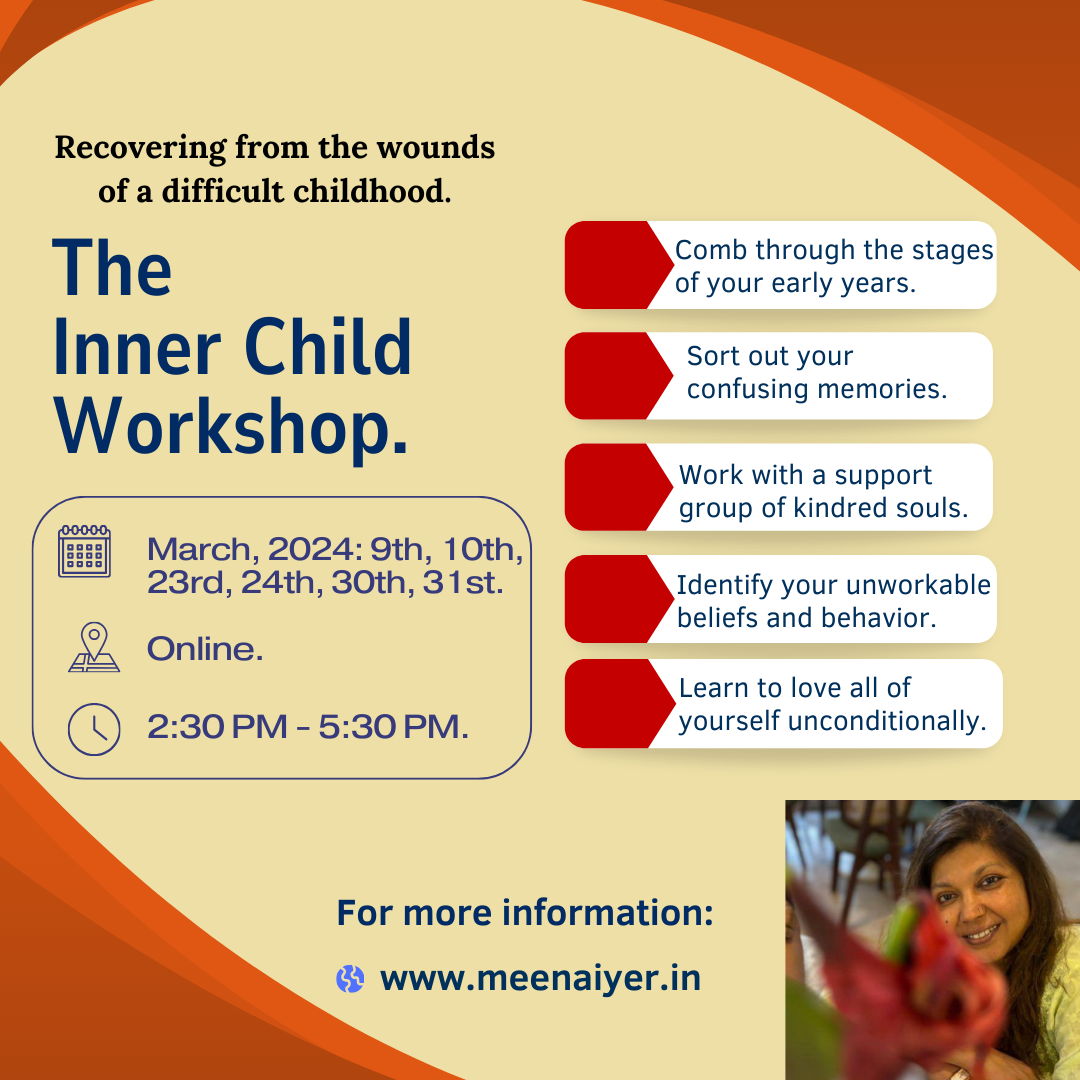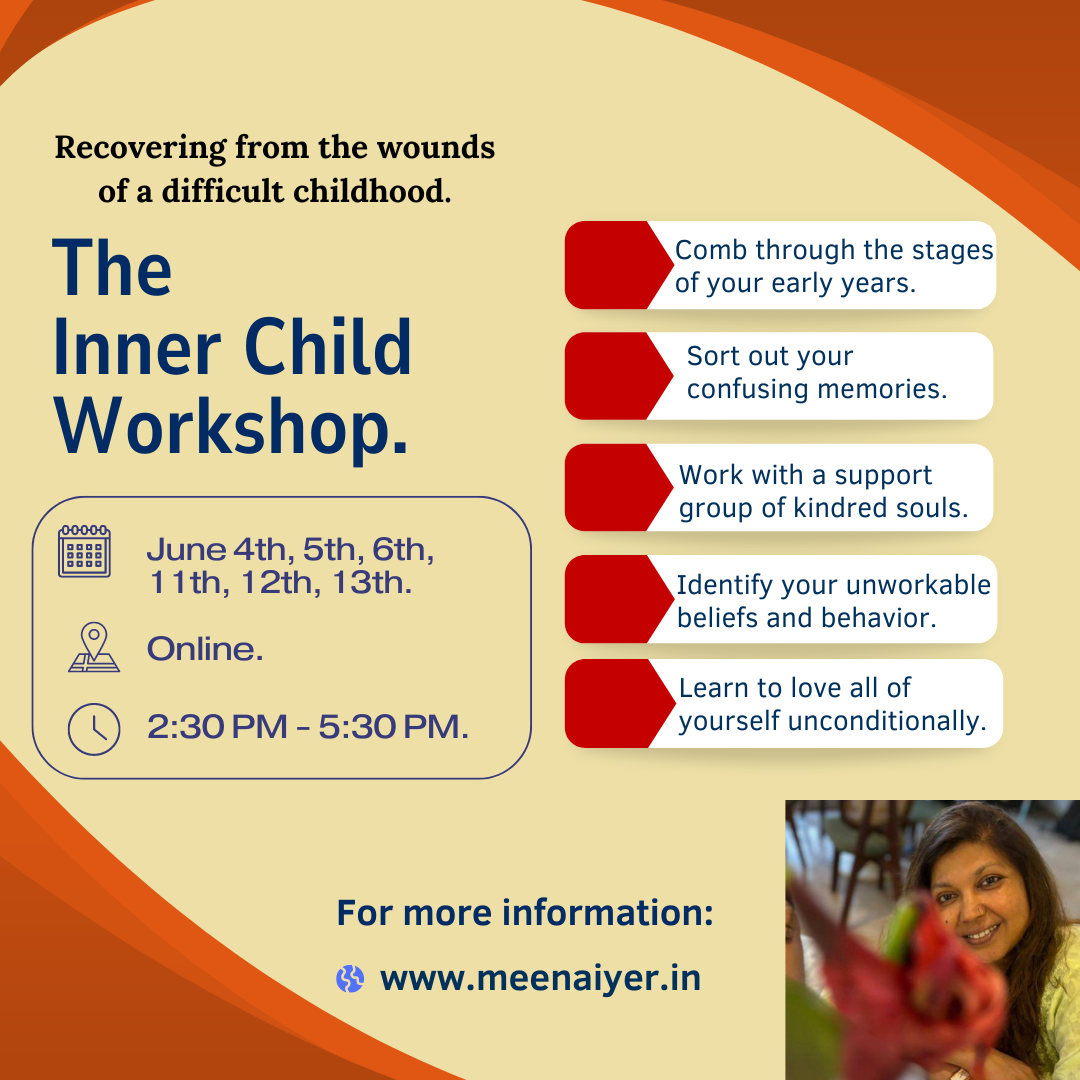Recovering from the wounds of a difficult childhood
Who am I
I am Meena Iyer, coach, healer and breathwork facilitator. I am writing to share my experiences in the fields of Holotropic Breathwork, Inner Child Healing and personal therapy and coaching.
Quick Intro and Disclaimer
I am Meena Iyer, coach, healer and breathwork facilitator. I have trained in counseling psychology, NLP, Hypnotherapy and breathwork facilitation. I have run my own de-addiction center in Gurgaon working individually and in groups with addicts, alcoholics and their families.I now offer one-on-one coaching and facilitate online and offline workshops/ retreats on Inner Child Healing and Breathwork.
Here is a disclaimer too. As I share my knowledge, experience and skills, they are constantly evolving and transforming, keeping pace with my own growth. If you feel ready to embark on this journey taking responsibility for the outcomes, hop on. The information shared here is for educational purposes only and not meant to substitute any professional guidance. There could be material not from the public domain which has been used to illustrate or explain only and not for infringement of intellectual property rights. Pls do not copy or share in any manner and infringe intellectual property rights. Information here is as understood and applied by me. Pls use your discretion while applying the same.

Meena Iyer, meenaiyer99@gmail.com, +91 9999966540.
Who is this post for (The Ultimate Guide to Inner Child Healing)
If you
- Are aware that your childhood years were difficult.
- Don’t have a clear memory of your childhood years and yet have a feeling in your gut that things were not pleasant.
- Find yourself justifying the actions of people in your life knowing that you were hurt.
- Feel confused about how to interpret things that happened in childhood.
- Are already in therapy or coaching seeking to accelerate your healing.
- Are actively seeking healing from significant emotional issues
- Are dealing with loss – death of a loved one, divorce or a broken relationship.
- Are looking to work on chronic unworkable behavior patterns.
- Are in a toxic relationship at home or work.
- Suffer from addictive behaviour – substances, activities or emotions.
- Practice psychotherapeutic or energy healing modalities
- You want to work on physical health issues.
Why am I writing this post?
Inner Child Healing is an important psychotherapeutic model conducted in groups or one-on-one. All our behaviour patterns can be traced back to our childhood experiences. The way we think, feel and behave originated either in support of or in defence of what unfolded before us in our early years. This post will provide a comprehensive guide to Inner Child Healing, including its core principles, practical approach and benefits. Whether you’re new to this technique, trying to decide if it is for you, or looking to deepen your understanding, this guide will provide valuable insights on the role that Inner Child Healing can play in your life. You have an opportunity to delve deep into the potential it has as a tool for inner transformation.
What is Inner Child Healing ?
Inner child healing is a journey of transformation that allows you to reconnect with and nurture the wounded aspects of your younger selves. This deep process makes it possible to heal childhood traumas, love and forgive yourself and build a rock-solid foundation for emotional well-being. In this comprehensive guide, we will explore the concept of the inner child, the impact of childhood experiences, and practical steps to embark on the path of healing.
Section 1: Understanding the Inner Child
1.1 Who is the Inner Child ?
The inner child is that part of you that still thinks, feels, responds and behaves like a child. Whenever you faced trauma in childhood, a part of you got frozen while the rest of you grew up. You continued doing the things you were expected to, at each stage, avoiding ever looking at this part.
Repetitive events only served to reinforce it.
When you were a child, you depended upon the adults in your life to care for you. You made the difficult journey – from feeling fused with your mother as an infant to developing an identity of your own, you kept coping with the situations that came up. You made tough choices, sometimes to just survive.
- As a child you need love, acceptance and unconditional positive regard to grow into a healthy mature adult.
- You need to be mirrored such that you build a strong core self.
- This does not happen if your caregivers themselves suffered from unresolved trauma. As they struggled, they were either absent or abusive.
- It is possible for you yourself to re-parent your inner child. It is your path to reclaim your life.
1.2 The Role of the Inner Child in Adult Life
Your childhood experience is the basis of how you understand the world. If you experienced early life as a battle to survive, you grew up believing that is what it was. You signed up to continue fighting. On the contrary if you were spoilt and grew up entitled you constantly depend on others to meet your needs. In either case you have no freedom or ease. You cope with the demands of your work and relationships feeling something’s not quite right. You struggle with structure and discipline or you become a willing puppet allowing others to dictate your priorities and play your feelings.
Your inner child shows up in many ways.
1.Thinking – In certain areas your thoughts are immature and illogical and you either discover this for yourself or are told by others
2. Feeling – You either suppress emotions – sadness, anger, fear guilt and shame or are overpowered by them.
3 Behavior – Prompted by your thoughts and feelings, your behavior is either inhibited and awkward or it can be inappropriate leading you to regret later.
Section 2: Unpacking Childhood Trauma
2.1 Types of Childhood Trauma
- Trauma or wounding occurs through neglect and abuse.
- Neglect – If your caregivers were too busy, stressed or unwell to attend to your needs, you suffer from neglect and abandonment
- Abuse – If you were actively hurt, these physical, emotional, and sexual wounds continue to influence you in adulthood.
- The ways in which you chose to deal with neglect or abuse created unviable patterns of behavior that persist long after the precipitating stimuli cease to exist.
2.2 The Long-term Effects of Childhood Trauma
- When you were wounded as a child, the impact first shows up psychologically as irrational thought patterns and defence mechanisms.
- Your relationship with yourself is full of criticism and blame.
- Your relationships with others are either distant and lacking in connection or codependent and lacking in boundaries.
- Your work life is full of unresolved conflict, you feel unable to trust others taking on more than your share of responsibilities or get dominated and controlled.
- You have chronic aches or disorders of your digestive, respiratory, reproductive, endocrine systems.
- You suffer from addictions of substance, activity or emotion.
- Your psychological patterns become psychiatric illnesses such as anxiety, depression, and PTSD.
Section 3: The Inner Child Healing Process
3.1 Building a Connection with your Inner Child
- The process of healing your inner child begins with acknowledging there is an inner child.
- Then you can build a connection by visualizing your inner child at different stages of development and communicating with them.
- Once a connecting bridge is built, you start recognizing your inner child’s needs and begin nurturing them in healthy ways.
- As your inner child begins to trust you, it becomes possible to build a nurturing relationship.
3.2 Acknowledging and grieving your childhood pain
- Seeing your childhood trauma and acknowledging it is the beginning of inner child recovery.
- You can truly grieve the sadness, give yourself permission to feel angry, allow your fears and let go of your shame that led you to believe that you were faulty.
- You can forgive yourself and release the guilt that you carried for so long.
3.3 Building self awareness and self compassion
- Once you have become aware of your child self it becomes possible to be kinder to yourself.
- Your self-criticism gives way to self-compassion.
- You are able to provide love, care and where they are needed structure and discipline to your inner child.
3.4 Expression for Inner Child Healing
- Writing with love to your inner child and writing as the inner child to your adult self are therapeutic.
- Other forms of expression like art and dance allow your inner child to heal trauma and find freedom.
3.5 Inner Child Visualization and Affirmation
- Guided visualization practices to foster a sense of safety and security and rewrite negative childhood experiences.
- Anchoring affirmations to rewire your thinking pathways.
Section 4: Overcoming Common Challenges
4.1 Resistance to Inner Child Work
- You view Inner Child work as blame directed towards your parents, siblings, teachers and other significant figures when in truth it supports your understanding of your own pain and the healing and integration of the painful parts of you.
- You fear that Inner Child work might keep you stuck in victimhood. In reality, it helps you break free from the drama of victim, aggressor and rescuer.
- You fear re-living the old traumatic stories. In the safe container of the therapeutic framework, you actually face your true feelings fully in order to let them go.
4.2 Working with a Group
- The Inner Child group holds space for your healing guided by your facilitator.
- You are in a safe, confidential and non-judgemental environment where you can heal your pain.
- Your Inner Child healing work is ongoing in a therapeutic community that understands and supports you with love and compassion.
- Mutual trust is present to support your courageous journey. You get support as you support others like yourselves.
SUMMARY
In conclusion, inner child healing is a transformative process that allows individuals to reclaim their authenticity and cultivate a deeper connection with themselves. By understanding the impact of childhood experiences, acknowledging the existence of the inner child, and actively engaging in healing practices, individuals can embark on a journey of self-discovery and emotional well-being.

Leave a Reply